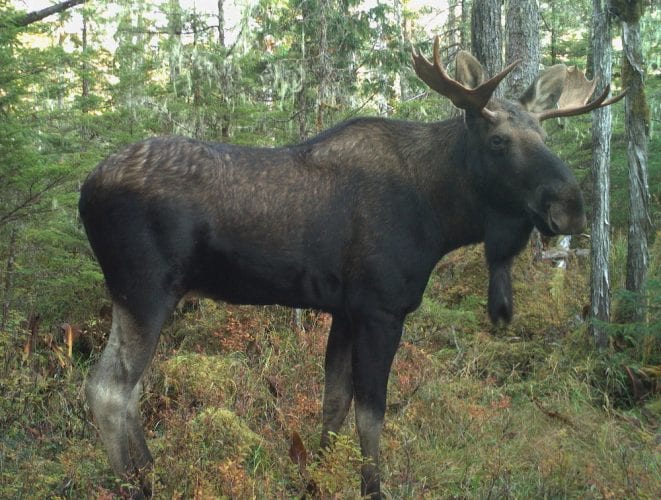
A three-year pilot study is underway to come up with an estimate of Sitka black-tailed deer numbers on Mitkof Island near Petersburg. The Alaska Department of Fish and Game will use a combination of techniques for counting deer and could use the results elsewhere in the region.
The pilot study just finished with the first year of field sampling on the island. That has meant DNA sampling of deer droppings as well as collecting photos from game cameras set up last fall along game trails.
“The goal is to develop a new approach to estimating deer abundance that will also give us some information about age structure of the population as well, so the number of fawns, does and bucks, is what we’d like to estimate,” said Dan Eacker, the Alaska Department of Fish and Game’s deer biologist for Southeast.
Fish and Game will use the DNA information from deer droppings combined with photos from the game cams to get a sense of the age structure for the deer populations and minimum daily counts of deer in those areas. Scientists also hope to learn about deer migration to higher elevations during the warmer month and learn about what part of the population doesn’t migrate. The aim is to capture deer when they are on their lower elevation winter range, when both migrants and resident deer are together lower down, surviving the snowier months.
In the past, Fish and Game has gathered a sense of the relative strength of deer numbers using two other methods. One has been simply counting deer droppings over set areas from year to year. Biologists have also flown aerial surveys to count deer in the high alpine. Those methods can give a sense of trends, rising or falling populations from year to year. But Eacker said he hopes this new study will give a better idea of actual numbers.
“Both of those methods are just sort of ways to index abundance so this is an actual way to come up with a population estimate rather than just an index of abundance, so it’s better information in that sense from a management standpoint,” Eacker said.

Wildlife population estimates are difficult in the thick timber of Southeast’s rainforest. Eacker said Mitkof Island is a good place to test this new combination of methods because of the road access around the island. That means easy access to the 64 game cameras, in four clusters on the island. He said the game cameras have already yielded some good photos.
“I actually just checked most of them a few weeks ago and we’ve already got some great pictures back of deer and moose and it’s pretty cool because we’re getting deer pictures of when they’re in the rut, so they have their antlers on and we’re also getting data on carnivore presence and absence from the cameras as well,” Eacker said.

He hopes the study will give an idea of how deer are impacted by winter weather and changes to habitat. And he explained that could inform bigger decisions on management of land and animals in the region.
“In some place that does have a deer conservation concern, especially some of the areas that have experienced heavy logging, could be really useful for the public and the (U.S.) Forest Service for their planning, just for the overall decision making process,” Eacker said. “So that’s what we aim to do is just provide high quality science and so, yeah just being able to estimate the age structure and abundance of deer will be a big step forward in Southeast if it works out well.”
The study involves two winters of DNA sampling, collecting photos over the three years and one year of collaring and tracking deer. Eacker said the plan is attach GPS collars to 20 does in February and March of 2020. That location information will improve estimates on use of the forest, selection of habitat and the range of those animals. Past studies of deer on the island have used VHF radio collars that give a less precise location.
The research will also capture some information from an expanded hunting season approved by the Board of Game this year. Hunters will have an additional three weeks of open season this year, including a week in November, closer to the rutting season and an easier time to hunt.
The overall hope of the pilot study is to develop a new mathematical model that can be used on deer populations elsewhere in Southeast. If it works well, the research could be expanded to the Lindenberg Peninsula on nearby Kupreanof Island. Eacker expects to have a final report out on his research in June of 2021 with annual progress reports this fall and next.









